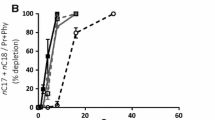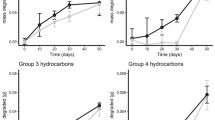Abstract
A group of five mesocosms (3.5 m3 each) located at Pointe-au-Père (St. Lawrence Estuary), Canada, was used to study the biodegradation of crude oil dispersed in cold and icy seawater (−1.8 to 5.5°C) under various environmental conditions. Experiments took place during autumn, winter, and spring and lasted from 2 weeks to 2 months. The bacterial response to the oil was assessed by recording the growth of total bacteria, viable heterotrophic bacteria, and oil-degrading bacteria. Some hydrocarbon ratios were calculated from gas chromatography in aliphatic and aromatic oil fractions and were used as biodegradation indices. A “Combined Index of Biodegradation” is proposed for assessing the overall biodegradation advancement. The winter period appeared critical for an oil spill in arctic/subarctic environments because of the reduced biodegradation under icy conditions. Crude oil adsorbed onto a substrate was found more degraded on its immersed part than on the emerged section exposed to winter conditions. Under more favorable environmental conditions (temperatures >0°C, effective chemical dispersion, oil release, spring microalgal bloom), the bacterial degradation would significantly alter the dissolved/dispersed oil within a few days. Under such conditions, half-life times of dissolved petroleum PAH ranged from 1.5–1.7 days (naphthalene) to 2.4–7.5 days (dimethylphenanthrenes), depending on the contamination level. In microenvironments where oil residues accumulated with biological detritus (surface microlayer, settling matter), the oil biodegradation was naturally enhanced. In contrast, water-in-oil emulsions recovered at the surface of mesocosms were unaltered after one month exposure in autumn.
Similar content being viewed by others
References
Alexander M (1985) Biodegradation of organic chemicals. Environ Sci Technol 18:106–111
API (1986) The role of chemical dispersants in oil spill control. American Petroleum Institute (ed.), Publ. No. 4425, Washington DC, 39 pp
Atlas RM, Bartha R (1972) Biodegradation of petroleum in seawater at low temperatures. Can J Microbiol 18:1851–1855
—, — (1992) Hydrocarbon biodegradation and oil spill bioremediation. In: Marshall KC (ed) Advances in microbial ecology vol. 12. Plenum Press, NY, chap 6, pp 287–338
Atlas RM, Horowitz A, Busdosh M (1978) Prudhoe crude oil in arctic marine ice, water, and sediment ecosystems: Degradation and interactions with microbial and benthic communities. J Fish Res Board Can 35:585–590
Atlas RM, Boehm PD, Calder JA (1981) Chemical and biological weathering of oil from the Amoco Cadiz spillage, within the littoral zone. Estuarine and Coast Shelf Sci 12:589–608
Bianchi AP, Bianchi CA, Varney MS (1989) Marina developments as sources of hydrocarbon inputs to estuaries. Oil Chem Pollut 5:477–488
Boehm PD, Fiest DL, Mackay D, Paterson S (1982) Physical-chemical weathering of petroleum hydrocarbons from the Ixtoc I blowout: Chemical measurements and a weathering model. Environ Sci Technol 16:498–505
Blumer M, Ehrhardt M, Jones JH (1973) The environmental fate of stranded crude oil. Deep Sea Res 20:239–259
Cain RB (1981) Microbial degradation of surfactants and “builder” components. In: Leisinger T, Hutter R, Cook AM, Nuesch J (eds) Microbial degradation of xenobiotics and recalcitrant compounds. Academic Press, London, pp 325–370
Cerniglia CE, Heitcamp MA (1989) Microbial degradation of polycyclic aromatic hydrocarbons in the aquatic environment. In: Varanasi U (ed) Metabolism of polycyclic aromatic hydrocarbons in the aquatic environment. CRC Press, Boca Raton, FL, pp 41–68
Dean-Raymond D, Bartha R (1975) Biodegradation of some polynuclear aromatic petroleum components by marine bacteria. Developments in Industrial Microbiology 16:97–110
Delille D, Bouvy M (1989) Bacterial responses to natural organic inputs in marine subantarctic area. Hydrobiologia 182:225–238
Delille D, Siron R (1993) Effect of dispersed oil on heterotrophic bacterial communities in cold marine waters. Microb Ecol 25:263–273
Delille D, Vaillant N (1990) The influence of crude oil on the growth of subantarctic marine bacteria. Antarctic Sci 2:123–127
Eimhjellen K, Nilssen O, Josefsen K, Sommer T, Sendstad E, Sveum P, Hoddo T (1982) Microbiology: II. Biodegradation of oil, 1981 study results. Baffin Island Oil Spill (BIOS) Working Report 81-6, Edmonton, Alberta, Canada, 57 pp
El Samra MI, Emara HI, Shunbo F (1986) Dissolved petroleum hydrocarbon in the northwestern Arabian Gulf. Mar Pollut Bull 17:65–68
Franklin FL, Lloyd R (1986/87) The relationship between oil droplet size and the toxicity of dispersant/oil mixtures in the standard MAFF “sea” test. Oil Chem Pollut 3:37–52
Griffiths RP, MacNamara TM, Cadwell BA, Morita RY (1981) Field observations on the acute effect of crude oil on glucose and glutamate uptake in samples collected from Arctic and subarctic waters. Appl Environ Microbiol 41:1400–1406
Herbes SE, Southworth GR, Shaeffer DL, Griest WH, Maskarinec MP (1980) Critical pathways of polycyclic aromatic hydrocarbons in aquatic environments. In: Witschi H (ed) The scientific basis of toxicity assessment. Elsevier, North-Holland Biomedical Press, pp 113–128
Hobbie JE, Daley RJ, Jasper S (1977) Use of nucleopore filters for counting bacteria by fluorescence microscopy. Appl Environ Microbiol 33:1225–1228
Hodson RE, Azam F, Lee RF (1977) Effects of four oils on marine bacterial populations: Controlled ecosystem pollution experiment. Bull Mar Sci 27:119–126
Horowitz A, Atlas RM (1977) Continuous open flow-through system as a model for oil degradation in the Arctic Ocean. Appl Environ Microbiol 33:647–653
Kaneko T, Atlas RM, Krichevski M (1977) Diversity of bacterial populations in the Beaufort Sea. Nature 270:596–599
Lee K, Levy EM (1989) Biodegradation of petroleum in the marine environment and its enhancement. In: Nriagu JA (ed) Aquatic Toxicology and Water Quality Management, John Wiley and Sons, NY, pp 217–243
Leahy JG, Colwell RR (1990) Microbial degradation of hydrocarbons in the environment. Microbiol Rev 54:305–315
Lelong PP, Bianchi MA, Martin YP (1980) Dynamique des populations planctoniques et bactériennes au cours d'une production expérimentale de phytoplancton marin naturel. II. Structure et physiologie des populations et leurs interactions. Can J Microbiol 26:297–307
Mackay D, McAuliffe CD (1988) Fate of hydrocarbons discharged at sea. Oil Chem Pollut 5:1–20
Madsen EL (1991) Determining in-situ biodegradation: Facts and challenges. Environ Sci Technol 25:1663–1673
McAuliffe CD (1987) Organism exposure to volatile/soluble hydrocarbons from crude oil spills. A field and laboratory comparison. In: American Petroleum Institute (ed) Proceedings 1987 Oil Spill Conference. Washington DC, pp 275–288
Nalewajko C, Schindler DW (1976) Primary production, extracellular release and heterotrophy in two lakes in the ELA, northwestern Ontario. J Fish Res Board Can 33:219–226
Parsons TR, Harrison PJ, Acreman JC, Dovey HM, Thompson PA, Lalli CM, Lee K, Guanguo L, Xiaolin C (1984) An experimental marine ecosystem response to crude oil and Corexit 9527: Part 2-Biological effects. Mar Environ Res 13:265–275
Pelletier E, Brochu C, Roy S, Mayzaud P (1989) New protected experimental tanks for environmental studies under severe weather conditions. In: American Petroleum Institute (ed) Proceedings 1989 Oil Spill Conference. Washington, DC, p 524
Pelletier E, Ouellet S, Pâquet M (1991) Long-term chemical and cytochemical assessment of oil contamination in estuarine intertidal sediments. Mar Pollut Bull 22:273–281
Perry JJ (1979) Microbial cooxidations involving hydrocarbons. Microbial Rev 43:59–72
Pritchard PH, Costa CF (1991) EPA's Alaska oil spill bioremediation project. Environ Sci Technol 25:372–379
Rontani J-F, Giusti G (1986) Study of the biodegradation of poly-branched alkanes by a marine bacterial community. Marine Chem 20:197–205
Roy S, Siron R, Pelletier E (1991) Comparison of radiocarbon uptake and DCMU-fluorescence techniques in evaluating dispersed oil effects on phytoplankton photosynthetic activity. Water Res 25:1249–1254
Saliot A (1981) Natural hydrocarbons in seawater. In: Duursma EK, Dawson R (eds) Marine Organic Chemistry. Elsevier, Amsterdam, pp 327–374
Siron R, Giusti G, Blanc F (1987) Hydrocarbons in the water column of the Carteau Bay (Gulf of Fos-sur-mer, Mediterranean Sea). Marine Chem 21:75–89
Siron R, Pelletier E, Brochu C (1991) Suivi d'une contamination pétrolière accidentelle dans l'estuaire moyen du Saint-Laurent: Le cas de l'Ile-aux-Grues. Water Pollut Res J Canada 26:61–86
Siron R, Pelletier E, Delille D, Roy S (1993) Fate and effects of dispersed crude oil under icy conditions simulated in mesocosms. Marine Environ Res 35:273–302
Siron R, Pelletier E (1994) Toxicity assessment of oil components and oil treating agents using the Photobacterium phosphoreum bioassay. In: Can Tech Rep Fish Aquat Sci No. 1989, Fisheries and Oceans Canada, pp 164–178
Sommerville HJ, Bennett D, Davenport JN, Holt MS, Lynes A, Mahieu A, McCourt B, Parker JG, Stephenson RR, Watkinson RJ, Wilkinson TG (1987) Environmental effect of produced water from North Sea oil operations. Marine Pollut Bull 18:549–558
Walker JD, Colwell RR (1976) Enumeration of petroleum-degrading microorganisms. Appl Environ Microbiol 31:198–207
Wolff GA, Preston MR, Harriman G, Rowland SJ (1993) Some preliminary observations after the wreck of the oil tanker Braer in Shetland. Marine Pollut Bull 26:567–571
Zobell CE (1973) Bacterial degradation of mineral oils at low temperatures. In: Ahearn DG, Meyers SP (eds) The microbial degradation of oil pollutants. Louisiana State University, Baton Rouge LA, pp 153–161
Author information
Authors and Affiliations
Rights and permissions
About this article
Cite this article
Siron, R., Pelletier, É. & Brochu, C. Environmental factors influencing the biodegradation of petroleum hydrocarbons in cold seawater. Arch. Environ. Contam. Toxicol. 28, 406–416 (1995). https://doi.org/10.1007/BF00211621
Received:
Revised:
Issue Date:
DOI: https://doi.org/10.1007/BF00211621




